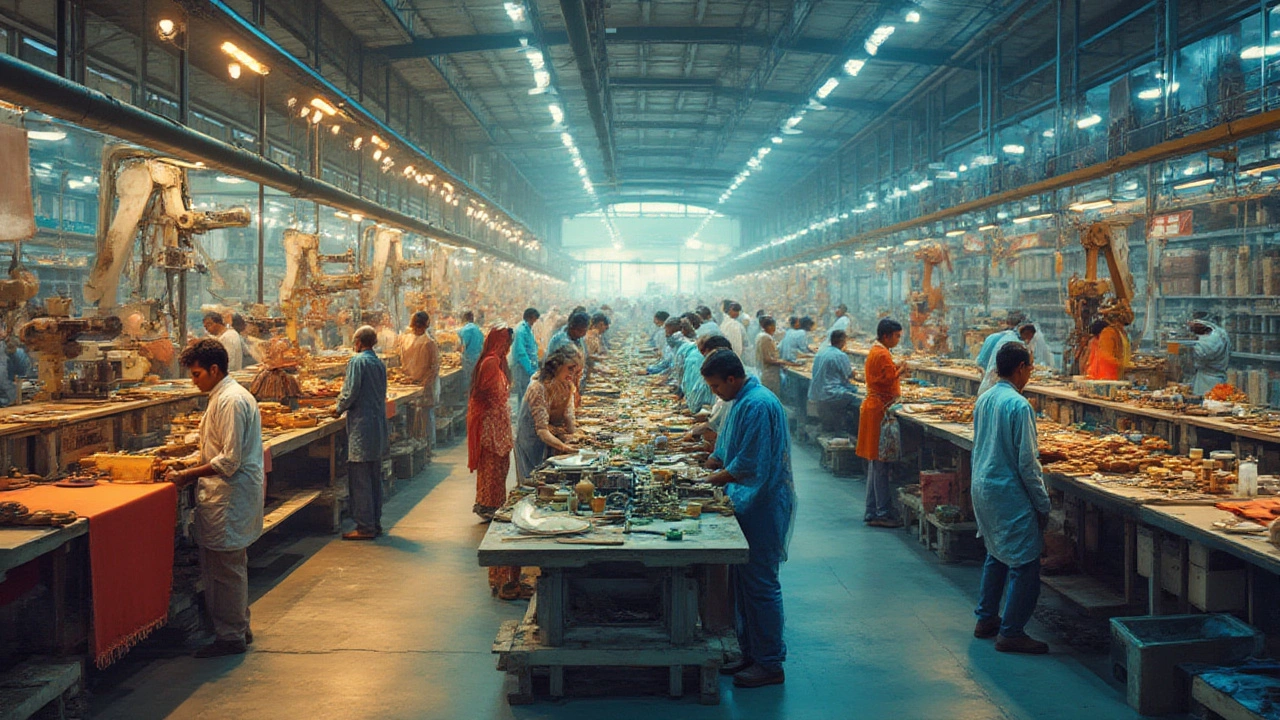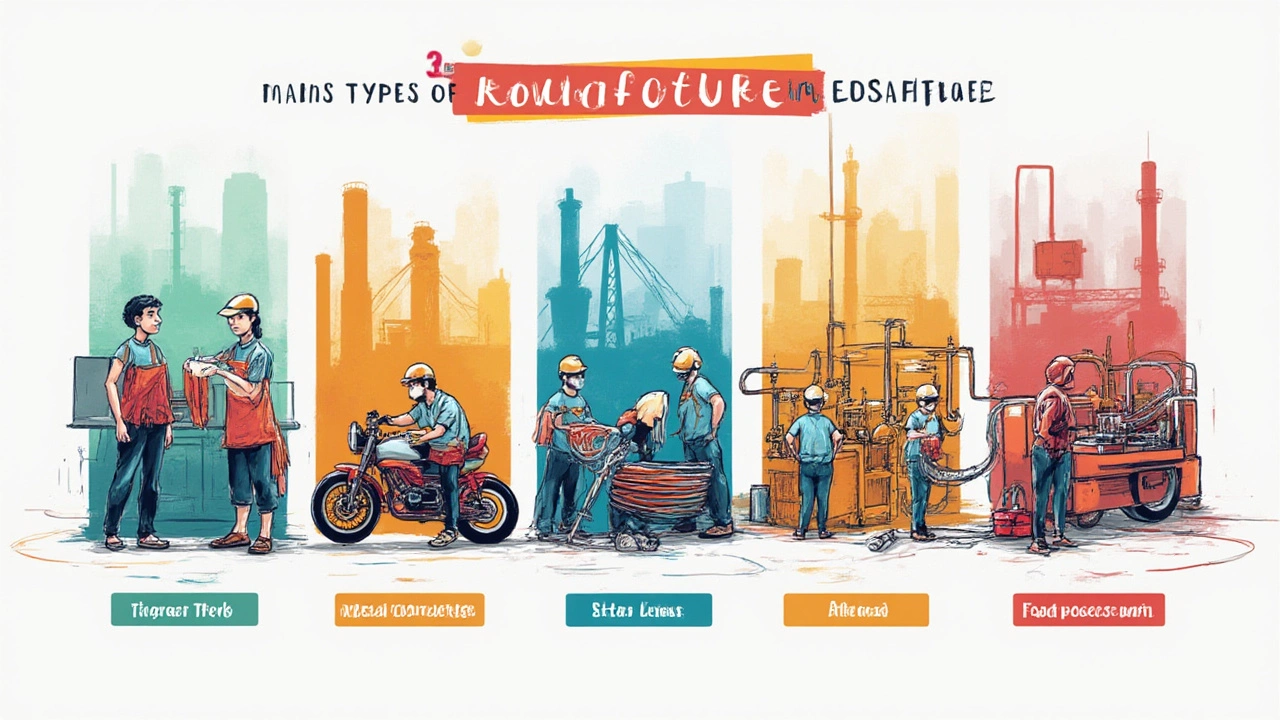5 Types of Manufacturing Methods Explained: A Guide for 2025

Imagine walking into your kitchen and grabbing a mug. Ever stop to think about how it was made? Most of us don’t. But that mug could’ve rolled off an assembly line in China, or maybe it was hand-crafted by a small ceramics shop downtown. Yet, both are products of manufacturing—just wildly different types. The way things get made isn’t a neat, one-size-fits-all answer. In 2025, with supply chains bending under global pressure and new tech popping up left and right, the way we make stuff has never been more interesting—or more vital to understand.
Job Shop Manufacturing
If you’ve ever needed something custom—from a car bumper repaired after a fender bender to a bespoke bicycle frame—you’ve bumped into job shop manufacturing, even if you didn’t realize it. This is the jack-of-all-trades approach. Instead of cranking out thousands of the same widget all day, job shops work in smaller batches. They might handle one type of part on Monday and switch gears midweek for something completely different. There’s flexibility, but also complexity.
Picture a local machine shop stuffed with lathes, mills, and a crew of machinists. They get blueprints, adapt their setups, and produce parts or tools customized for each order. The beauty here? You can get something unique, like a replacement lever for your ancient espresso machine, that’d never survive in mass production because no one else needs it. You’ll see job shops everywhere: custom metalwork, prototyping for startups, and places fixing rare car parts for enthusiasts who’ll pay a premium for what big manufacturers won’t touch.
The catch? This flexibility comes at a cost. Since job shops change setups all the time, they spend more on labor and have a higher per-unit price. There’s less efficiency, and lead times can get long. Still, when you need it your way—or when huge minimums scare you off—it’s job shop manufacturing you’ll end up thanking.
Did you know job shops powered some big shifts? During the height of the COVID-19 pandemic, loads of small shops pivoted in a matter of weeks to produce face shields and ventilator parts—that type of adaptability is the hallmark of this approach.
Batch Manufacturing
Think about your favorite local bakery. They don’t bake a single cupcake at a time and call it a day—they work in batches. That’s exactly how batch manufacturing works, but on a much larger, industrial scale. It’s the sweet spot between the one-off world of job shops and the industrial behemoth of mass production.
Here, products are made in loads—or batches—where everything is completed for one group before the process resets for the next. For example, a paint factory may mix up a batch of blue paint, fill thousands of cans, and only once that run is finished, switch everything over to green. In pharmaceuticals, batch manufacturing is still huge, especially for medications made in limited quantities or with short shelf lives.
This method balances efficiency with variety. It works best for companies that need some versatility, but produce enough volume where true customization isn’t worth it. Bakeries, breweries, paint companies, pharmaceuticals, even electronics manufacturers doing seasonal runs—batch manufacturing is everywhere.
The upside? Companies can adjust quickly for changes in demand, color, flavor, or size. The downside? There’s downtime and extra cost whenever you switch batches—equipment needs to be cleaned, recalibrated, sometimes even rebuilt. Still, it’s far faster than job shops, and for most medium-volume goods, it’s the only process that makes sense.
Ever wonder why limited edition soda flavors vanish so fast once they drop in stores? Those are classic batch runs—made just long enough to satisfy the superfans before the factories pivot back to regular cola.

Repetitive Manufacturing
This is assembly-line classic territory. If you’ve toured a car plant or watched a documentary on electronic gadgets, you’ve seen repetitive manufacturing in action. This process is all about making piles of identical products, day after day. Factories are set up to hum along with high efficiency, and workers (or robots) crank out exactly the same part, over and over.
The benefit? Absolute efficiency. Repetitive manufacturing is clockwork—think cars, washing machines, or TVs. With specialized equipment, labor, and processes, every piece is virtually indistinguishable from the last. The setup doesn’t change. Assembly lines roll on. Companies love this because the more you make, the lower your cost per unit. It's why some TV brands can sell you a 65-inch model for less than a monthly grocery bill.
Here’s a real-world stat from the International Federation of Robotics: as of 2024, over 3.5 million industrial robots were at work in manufacturing plants worldwide, most of them in repetitive manufacturing. This isn’t an old-school fantasy—automation is already king in this world, what with its precision and appetite for endless work.
The catch is that repetitive manufacturing only truly makes sense for high-volume, low-variety products. There’s not a lot of room to get creative or add last-minute tweaks. Changeovers are expensive, so product lines are locked in for months—or years. That’s why, when Miles wanted a custom decal for his bicycle last year, factory automation wasn’t the answer. This type of manufacturing trades flexibility for scale, and if you’re after one-of-a-kind, you’ll have to look elsewhere.
Continuous Process Manufacturing
If you turn on a faucet and pour a glass of tap water, you might not guess it took some massive science to make it safe. But underneath any city, around the clock, water treatment plants are humming away in a seamless operation. That’s continuous process manufacturing—where production never stops, and flow is king.
Chemical plants, oil refineries, paper mills—these are the poster children for this process. Unlike batch or job shop manufacturing, where you pause between products or orders, continuous processes run 24/7. They’re optimized for volume: liquids, gases, chemicals, or even foods like flour or sugar. The product is pumped, refined, or mixed in huge quantities, with quality checks happening on the fly. No downtime, no start or stop, just endless flow.
This approach relies heavily on technology. Sensors, control systems, and automation keep everything moving with minimal human interference. Why? Any pause could risk contamination or catastrophic loss. Most of the world’s gasoline, plastics, or even basic medicines come from continuous plants.
The benefit is massive: ultra-low cost per unit and reliability. The drawbacks? Inflexibility and astronomical setup costs. You can’t simply pause a polymer line, decide to switch over to something else, and head home for dinner. Changeovers are rare—when they happen, it’s a major event with weeks of planning.
Check out the numbers: The American Chemistry Council reported that in 2023, U.S. chemical companies produced over 900 million tons of chemicals—almost all via continuous process plants. It’s a reminder that nearly every home in the country relies on invisible, nonstop giants.

Additive Manufacturing (3D Printing)
Now for the wild card: additive manufacturing, or what most folks call 3D printing. Not long ago, this was the hobbyist’s playground. Fast forward to today, and you’ll find companies prototyping jet turbine blades, surgeons making custom implants, even local schools churning out robotics parts—all with the same core process: building up products layer by layer from digital designs.
Additive manufacturing flips the traditional script. Instead of carving, stamping, or pouring to shape a product, it builds up material—plastic, metal, resin—from the ground up. The design starts on a computer, slices into ultra-thin layers, then the printer works its magic, fusing each slice until a full item emerges. The magic? Parts with complex geometries or hollow spaces—impossible with old-fashioned methods—become simple to make.
This method isn’t just for prototypes. As of 2024, more than 30% of aerospace engine brackets in new commercial planes are 3D-printed, thanks to their lighter weight and strength. The dental industry? Almost all custom night guards and aligners now start with a mouth scan and end on a 3D printer.
Here’s what makes additive manufacturing such a disruptor: no tooling or molds, almost zero waste, and the ability to make just one unit without breaking the bank. Perfect for custom parts, medical devices, or short production runs. The downside is that printing large runs is still pretty slow compared to repetitive manufacturing, and costs can shoot up for big items or mass production. But for design freedom and on-demand production, nothing comes close.
It won’t replace traditional methods, but it’s changing what’s possible. Next time your kid brings home a school trophy or needs a science project—ask where (and how) it was made. Odds are, additive manufacturing had a hand in it.
| Manufacturing Type | Flexibility | Best For | Examples |
|---|---|---|---|
| Job Shop | Very High | Custom orders, low volume | Machine shops, prototypes |
| Batch | High | Medium volume, some variety | Paint, baked goods, drugs |
| Repetitive | Low | High volume, low variety | Cars, electronics, appliances |
| Continuous Process | Very Low | Huge volume, no stoppage | Chemicals, gasoline, cement |
| Additive (3D Printing) | Extremely High | Custom, prototyping, small runs | Dentistry, aerospace, models |
Every single product in your life—yeah, even the ones lying forgotten in your junk drawer—came from one of these five manufacturing types. And as new tech keeps making the impossible look easy, understanding these core processes means you’re ready to spot trends, chase opportunities, or—at the very least—appreciate what went into creating the next gadget you buy. The world’s getting more complex, but the basics still matter. And honestly, knowing just a bit about how things are made pays off every time you pick up something and wonder, “How did they do that?”